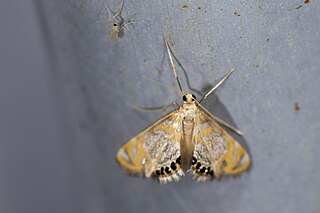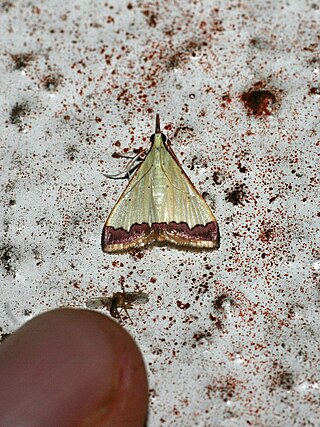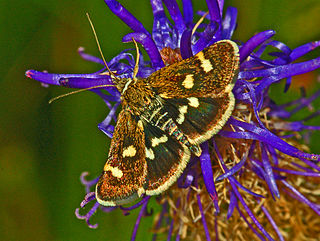
Crambidae comprises the grass moth family of lepidopterans. They are variable in appearance, with the nominal subfamily Crambinae taking up closely folded postures on grass stems where they are inconspicuous, while other subfamilies include brightly coloured and patterned insects that rest in wing-spread attitudes.
Dicepolia is a genus of moths of the family Crambidae.

Nymphicula is a genus of moths of the family Crambidae.

Palpita is a genus of moths of the family Crambidae. Members of the moth genus Stemorrhages may be very similar in appearance.

Autocharis hedyphaes is a moth of the family Crambidae described by Alfred Jefferis Turner in 1913. It is found in south-eastern Asia, including Malaysia. It is also present in Australia in northern Queensland.

Diaphania hyalinata, the melonworm moth, is a moth of the family Crambidae. It is found in eastern North America, south to Central and South America, including Suriname and the Caribbean.
Agriphila aeneociliella, the eastern grass veneer, is a species of moth in the family Crambidae. It is found from Denmark, Poland, Ukraine and Romania through Russia to Manchuria, northern China, Korea and Japan.
Dicepolia marionalis is a species of moth of the family Crambidae. It is found in Madagascar.

Odontiinae is a subfamily of moths of the family Crambidae. The subfamily was described by Achille Guenée in 1854.

Scopariinae is a subfamily of the lepidopteran family Crambidae. The subfamily was described by Achille Guenée in 1854.
Cliniodes opalalis is a moth in the family Crambidae. It was described by Achille Guenée in 1854. It is found in Central America, north to southern Mexico. It is also found in Cuba, Jamaica and in the Andes from Colombia to Bolivia. It has also been recorded from northern Venezuela, Trinidad and Tobago and north-eastern Brazil.
Dicepolia aerealis is a moth in the family Crambidae. It was described by James E. Hayden in 2009. It is found in Costa Rica (Guanacaste) and Venezuela (Barinas).
Dicepolia amazonalis is a moth in the family Crambidae. It was described by James E. Hayden in 2009. It is found in the central Amazon basin, along the main trunk of the Amazon River and its tributaries.
Dicepolia cuiabalis is a moth in the family Crambidae. It was described by James E. Hayden in 2009. It is found in Brazil, where it has been recorded from Mato Grosso.
Dicepolia vaga is a moth in the family Crambidae. It was described by James E. Hayden in 2009. It is found in the Andes in Ecuador, as well as in Panama and montane Jamaica.
Dicepolia venezolalis is a moth in the family Crambidae. It was described by James E. Hayden in 2009. It is found in Amazonas in Venezuela and in French Guiana.
Dicepolia nigritinctalis is a moth in the family Crambidae. It was described by James E. Hayden in 2010. It is found in Cuba and Chiapas in Mexico.
Dicepolia rufeolalis is a moth in the family Crambidae. It was described by Paul Mabille in 1900. It is found on Madagascar.
Palpita kiminensis is a moth in the family Crambidae. It was described by Jagbir Singh Kirti and H. S. Rose in 1992. It is found in north-eastern India, China, Nepal, Myanmar, Thailand, Vietnam, Borneo, Sumatra and northern Australia.






